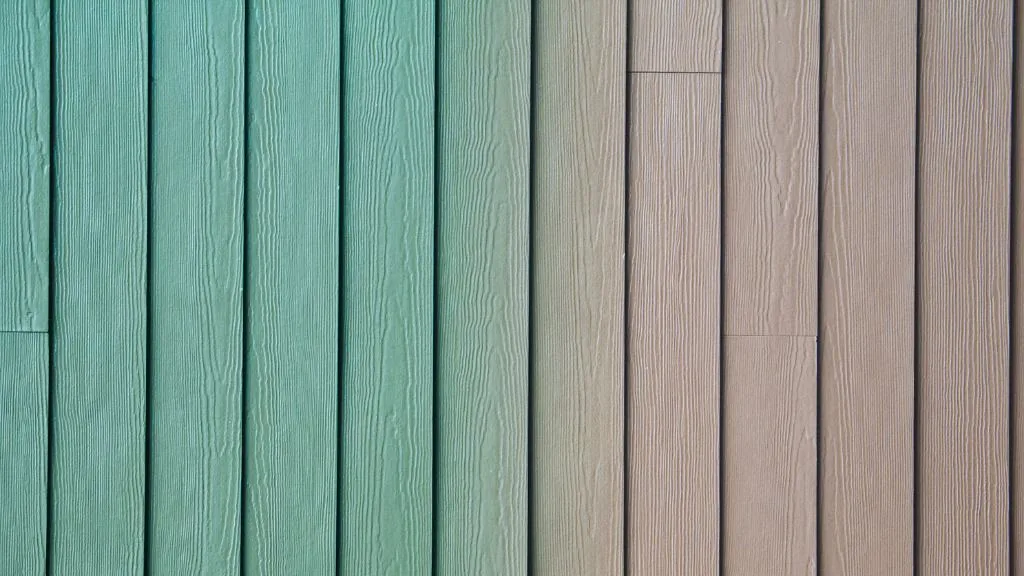
Vinyl siding is a popular choice for homeowners due to its durability, affordability, and low maintenance requirements. However, if you’ve recently had a paint job gone wrong, you might be wondering how to get paint off your vinyl siding without damaging it.
Removing paint from vinyl siding can be a tricky process, but with the right tools and techniques, you can get your siding looking as good as new. In this article, we’ll provide you with expert tips and tricks on how to get paint off vinyl siding safely and effectively.
We’ll explore various methods for removing paint, from using household items to professional-grade products. Whether you’re a DIY enthusiast or a homeowner looking to fix a paint mishap, this guide will equip you with the knowledge and tools to get the job done right.
So, let’s get started and discover how to get paint off vinyl siding!

Types of Paint on Vinyl Siding
There are various types of paint that you might find on vinyl siding, each with its own characteristics and methods for removal. Understanding the differences between them will help you choose the right cleaning solution and approach.
In this section, we will discuss water-based paint, oil-based paint, spray paint, latex paint, and urethane-based paint.
Water-Based Paint
Water-based paint, which includes acrylic and latex paint, is popular for painting homes and other large structures. It is easy to clean up and has high durability.
To remove water-based paint from vinyl siding, create a DIY cleaning solution using laundry detergent and warm water. Apply the solution to the paint, then gently scrub with a brush or scraper.
Rinse the area with a power washer, repeating the process if necessary.
Oil-Based Paint
Oil-based paint is more challenging to remove from vinyl siding due to its strong adhesion properties. You might need to use a paint thinner or acetone to break down the bond between the paint and the siding.
Be careful when using these solvents, as they can potentially dull the finish on your vinyl panels. Rub the solvent onto the paint stain, wait for a few minutes, and then gently scrub with a soft rag.
Spray Paint
Spray paint can be stubborn to remove from vinyl siding. However, some techniques that work on water-based and latex paint may also be effective on spray paint stains.
If these methods don’t work, try using acetone or a graffiti remover, following the same process as for oil-based paint stains. Always test in an inconspicuous area before proceeding to ensure that the finish on your siding is not damaged.
Latex Paint
Latex paint is another type of water-based paint that is easy to remove from vinyl siding. You can follow the same method as you would for water-based paint, using a cleaning solution made of warm water and laundry detergent.
Scrub the paint with a brush or scraper and rinse with a power washer as needed.
Urethane-Based Paint
Urethane-based paint is a durable and versatile coating, but it can be difficult to remove from vinyl siding. You may need to use a paint remover specifically designed for urethane-based paint, as well as a soft-bristle brush or scraper.
As always, test the paint remover in a small, hidden area to ensure it won’t damage the finish on your siding.
Apply the paint remover according to the manufacturer’s instructions, and then gently scrub or scrape the paint away. Rinse the siding with water to remove any residue.
Keep these various paint types in mind as you work on removing paint from your vinyl siding, ensuring that you use the appropriate method for the specific paint you’re dealing with. This will help you achieve the best results and protect your siding from damage.

Safety Precautions and Preparation
Before you start working on removing paint from your vinyl siding, it’s essential to take necessary safety precautions and gather the right materials for the job.
First and foremost, make sure you have the following materials:
- Clean rags or soft cloth
- Soft brush (nylon scrubber or scrub brush)
- Plastic scraper
- Acetone or turpentine (for oil-based paint)
- Mild detergent or dish soap
- Warm water
- Isopropyl alcohol (for tougher paint stains)
- A respirator or face mask
- Work gloves
- Safety goggles (optional, but recommended)
To ensure your safety during the paint removal process, follow these guidelines:
- Wear a face mask or respirator to protect yourself from inhaling any paint fumes or dust particles. This is especially important if you’re working with oil-based paint, acetone or turpentine, as these substances can be harmful if inhaled.
- Put on a pair of work gloves to protect your hands from any chemicals or sharp edges on the scraper while working. Vinyl siding can also become hot when exposed to the sun, so gloves will help prevent burns.
- If using a pressure washer, make sure to read and follow the manufacturer’s instructions regarding its proper use and safety precautions.
- Work in a well-ventilated area, ideally outdoors. This will help disperse any fumes from chemicals and provide a safer environment for the paint removal process.
- Consider wearing safety goggles, especially if using a pressure washer, to protect against any debris or water that may be sprayed during the cleaning process.
Now that you’re prepared with appropriate materials and safety measures in place, you can proceed confidently with the paint removal process on your vinyl siding.
Remember to test any cleaning solutions or methods in an inconspicuous area first to ensure they won’t cause damage or discoloration to your siding. Happy cleaning!
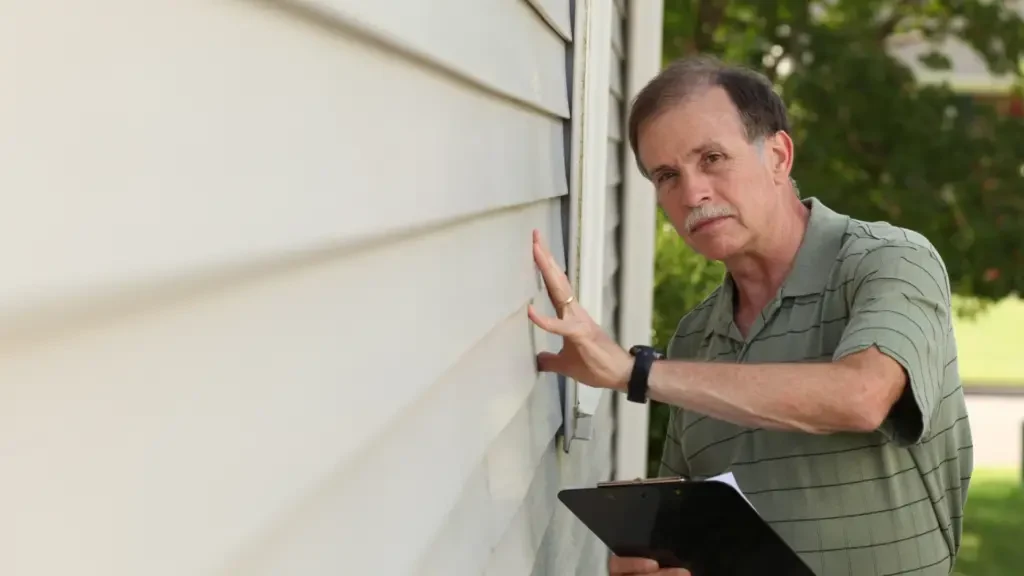
Removing Water-Based Paint Stains
Using Soap and Water
To remove water-based paint stains from your vinyl siding, start by mixing warm water and a mild detergent, such as laundry detergent, in a bucket. Use a soft brush to gently scrub the stained area, applying the soapy solution to loosen and lift the paint.
Be sure to work in small sections, as this will make it easier to manage the cleaning process.
Rinse the area thoroughly with fresh water, using a hose or a bucket, to ensure all soap and paint residue is removed. Depending on the size and severity of the paint stain, this process may need to be repeated several times before the stain is fully removed.
Using Rubbing Alcohol
If soap and water do not fully remove the paint stain from your vinyl siding, you can also try using isopropyl alcohol, commonly known as rubbing alcohol.
Follow these steps:
- Dampen a clean, soft cloth with rubbing alcohol.
- Gently rub the cloth over the affected area to break up the paint stain.
- Allow the rubbing alcohol to sit on the stain for a few minutes.
- Use a soft brush to scrub the area further, if necessary.
- Rinse the siding with fresh water to remove any alcohol and paint residue.
Remember, always test a small, inconspicuous area first before applying any cleaning solution or rubbing alcohol to your vinyl siding. This will help you ensure the chosen method does not cause any damage to the siding.

Removing Oil-Based Paint Stains
Using Mineral Spirits
To remove oil-based paint stains from your vinyl siding using mineral spirits, follow these steps:
- Put on your protective gloves and mask to safeguard against fumes and skin contact.
- Dampen a clean cloth with mineral spirits, and gently rub the paint stain in a circular motion.
- Allow the mineral spirits to sit on the stain for a few minutes to dissolve the paint.
- Use a soft-bristle brush to scrub the area gently until the paint starts to lift off.
- Rinse the area thoroughly with water to remove any residue.
- If stubborn stains persist, you may need to repeat the process.
Using Acetone
Acetone, found in nail polish remover and some paint thinners, is another effective solution for removing oil-based paint stains from vinyl siding. Here’s how:
- Ensure proper ventilation and wear gloves and a mask for protection.
- Soak a clean cloth in acetone or nail polish remover, then gently rub it onto the paint-stained area.
- Allow the acetone to sit on the stain briefly, breaking down the paint.
- Use a soft-bristle brush or plastic scraper to gently remove the loosened paint.
- Rinse the area with water to remove any remaining paint and solvent.
- If necessary, repeat these steps until the paint has been completely removed.
Remember to proceed with caution when using strong solvents like mineral spirits and acetone. Overuse or improper application can potentially damage your vinyl siding.
Removing Spray Paint and Graffiti
Using a Graffiti Remover
When attempting to remove graffiti or spray paint from your vinyl siding, consider using a graffiti remover. An effective option is Goof Off Graffiti Remover, which is specially designed to remove spray paint and other markings. To use it:
- Put on protective gloves and wear a mask to protect yourself from any harmful fumes.
- Apply the product to the affected area, following the manufacturer’s instructions.
- Leave the remover on the surface for the recommended amount of time.
- Gently scrub the area with a soft brush or a clean cloth to loosen the paint.
- Rinse the area with water, ensuring all the product is removed.
Repeat the process as needed until the paint is completely gone. Always follow the product’s directions and safety precautions.
Using a Paint Remover
If graffiti remover isn’t successful, you can try a paint remover like Motsenbocker’s Lift Off or Goo Gone. These products are designed to tackle a range of paint types, such as oil-based and latex paints.
To use them, follow these steps:
- Put on gloves and a face mask to protect yourself from any harmful chemicals.
- Apply the paint remover to the affected area using a clean cloth or a paintbrush.
- Allow the product to work for the specified amount of time as per the manufacturer’s instructions.
- Use a soft brush or a clean cloth to gently scrub the paint, taking care not to damage the vinyl siding.
- Rinse the area with water, making sure to remove all the paint remover.
It might take several attempts to completely remove the paint, so be patient and ensure the products are suitable for vinyl siding before using them. Always follow safety precautions and product instructions closely.
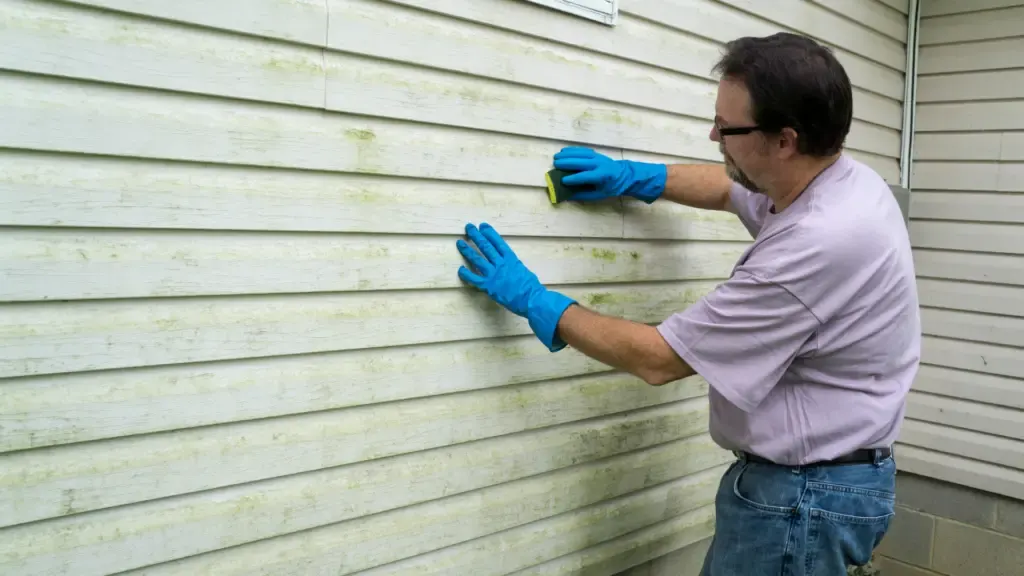
Sanding and Scraping Techniques
When trying to remove paint from vinyl siding, sanding and scraping techniques can be helpful. Let’s explore these methods and see which one works best for your situation.
Using a Scraper
A scraper can be an effective tool for removing dried paint from your vinyl siding. Here’s how you can use it:
- Choose a plastic scraper or a plastic spatula as your tool. Avoid using a metal scraper, as it can damage the vinyl.
- Gently work the scraper’s edge under the dried paint, applying pressure, and lift the paint away from the siding.
- Be cautious not to dig too deep or force the scraper, as you might leave scratches or marks on your vinyl siding.
Utilizing Steel Wool
Sometimes, steel wool might be necessary for removing stubborn paint stains. Here’s what you should do:
- Opt for a fine-grade steel wool pad to avoid causing damage to the vinyl siding.
- Dampen the steel wool pad slightly, as it can lubricate the surface and make the paint removal process smoother.
- Gently rub the steel wool pad over the paint stain in a circular motion, applying only enough pressure to remove the paint without causing damage.
Sanding Techniques
Lightly sanding your vinyl siding can also help in removing paint stains, especially when dealing with lighter-colored siding. Here are the steps:
- Choose very fine grit sandpaper, such as #320 or #220, for the job.
- Work on a small area at a time, gently rubbing the paint stain with the sandpaper.
- Be mindful of the pressure you’re applying, as excessive force may lighten the vinyl material or cause other damage.
Remember, always wear safety gear like gloves and safety glasses when working with scraping and sanding tools to protect yourself from any debris. By following these techniques, you should be able to remove paint stains from your vinyl siding without causing further damage effectively.
Using Power Washing and Cleaning Solutions
When removing paint from vinyl siding, power washing can be an effective method. Before you begin, ensure you have the necessary equipment, such as a pressure washer or power washer, a cleaning solution, dish soap, a soft cloth, and a soft-bristle brush.
To start, prepare your cleaning solution by adding dish soap to warm water. If you prefer, you can also use a mixture of 30% white vinegar and 70% water as an alternative cleaning solution.
Fill the pressure washer’s reservoir with the chosen solution, ensuring it remains submerged throughout the process.
Next, connect the pressure washer to your home’s garden hose and prepare to power wash the affected area. When using a power washer, it’s essential to follow these guidelines to avoid damaging the vinyl siding:
- Maintain a distance of at least 2 feet from the siding
- Use a broad spray nozzle setting
- Spray at-level or above, as spraying from below may force water under the siding
Once you’ve power washed the area, you might still see some paint remnants. In this case, you can use a soft cloth or a soft-bristle brush to gently scrub the siding, paying particular attention to any remaining paint spots.
Be sure not to apply excessive pressure to avoid scratching or damaging the siding.
After you’ve finished scrubbing, rinse the area with clean water using your pressure washer. Remember to maintain the same distance and nozzle settings previously mentioned.
Allow the siding to dry completely.
With these steps, you should be able to effectively remove paint from your vinyl siding using power washing and cleaning solutions. Remember to work carefully and patiently, and take all necessary precautions to protect your siding from potential damage during the process.
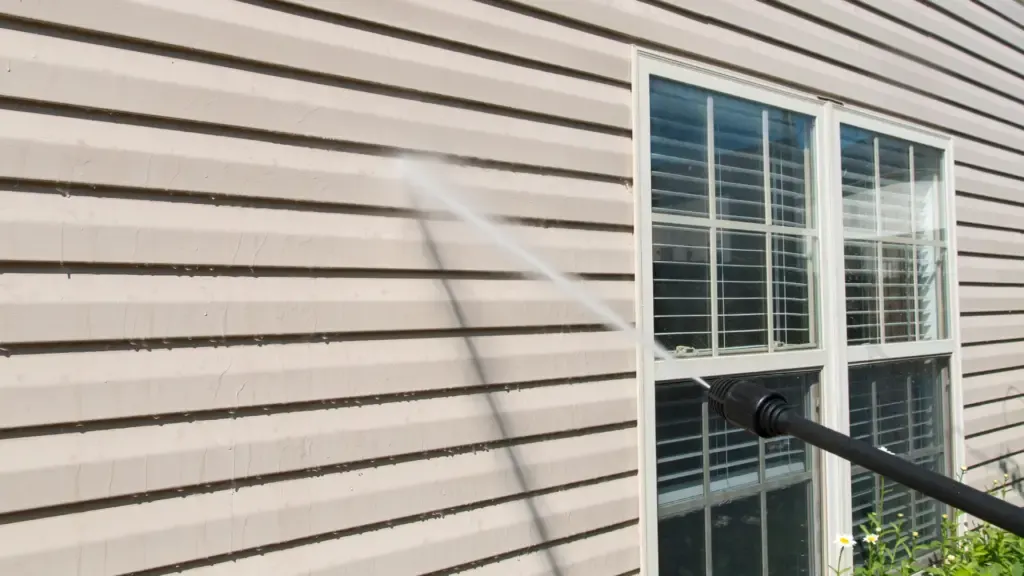
Working with Professionals
When deciding to remove paint from your vinyl siding, it is often beneficial to consult or hire a professional siding contractor. These experts are knowledgeable and experienced in working with vinyl siding and will ensure the job is done correctly and efficiently.
To start, look for local siding contractors who offer free estimates. This will allow you to receive a quote for the job and compare pricing among different professionals.
When getting estimates, be sure to discuss the specific paint removal methods they will use to ensure your vinyl siding is not damaged in the process. You can also use this time to inquire about their experience with similar projects and ask for references.
Here are some advantages of working with professionals:
- They have an in-depth understanding of the paint removal process for vinyl siding.
- They are equipped with the right tools and materials to do the job.
- They can complete the task efficiently and effectively, saving you time and possible frustration from attempting it yourself.
- Working with a professional minimizes the risk of damaging your vinyl siding, preserving its appearance and longevity.
When selecting a siding contractor, it’s essential to:
- Check for relevant licenses and insurance to ensure they are legitimate.
- Read online reviews and testimonials from previous clients to gauge their reputation.
- Confirm they have the appropriate skills and experience to handle the project.
By entrusting the paint removal process to a professional, you can ensure the job is completed with precision, preserving the appearance of your vinyl siding and avoiding any potential mishaps.
Vinyl Siding Maintenance and Care
Proper maintenance is essential for keeping your vinyl siding looking its best and extending its lifespan. Regularly cleaning off debris and dirt will not only maintain the exterior appearance of your home but will also enhance its curb appeal and overall property value. Here are some useful tips for taking care of your vinyl siding:
- Clean your siding regularly. To prevent the accumulation of dirt, debris, and mold, clean your siding at least once a year. Gently scrub the surface with a soft brush and a mixture of water and mild detergent. Remember to avoid using abrasive cleaners or scrubbing tools that may damage the siding.
- Inspect for damages. Regularly check your vinyl siding for any signs of damage or wear, such as buckling or warping. Promptly address these issues to maintain the structural integrity of your siding and prevent costly repairs.
- Consider the colors carefully. When choosing siding colors, opt for those that complement the overall design and style of your home. Lighter shades tend to be more forgiving when it comes to visible dirt, whereas bolder hues can make your property stand out in the neighborhood.
- Use the right primer for touch-ups. If you need to touch up some areas where the paint has peeled, be sure to use a primer specifically designed for use with vinyl siding. This will help ensure proper adhesion of the paint and protect your siding from further damage.
- Treat PVC pipes with care. If your siding has PVC components, such as pipes or trim, use a PVC pipe cleaner to maintain their appearance and functionality. This will help prevent any unsightly yellowing or discoloration.
- Maintain structural support. To avoid issues like buckling or warping, ensure that the vinyl siding is correctly installed and has proper support. Proper installation will not only enhance the curb appeal of your home but may also contribute positively to your property value.
By following these maintenance and care tips, you can preserve the appearance and longevity of your vinyl siding, ensuring your home looks its best for years to come
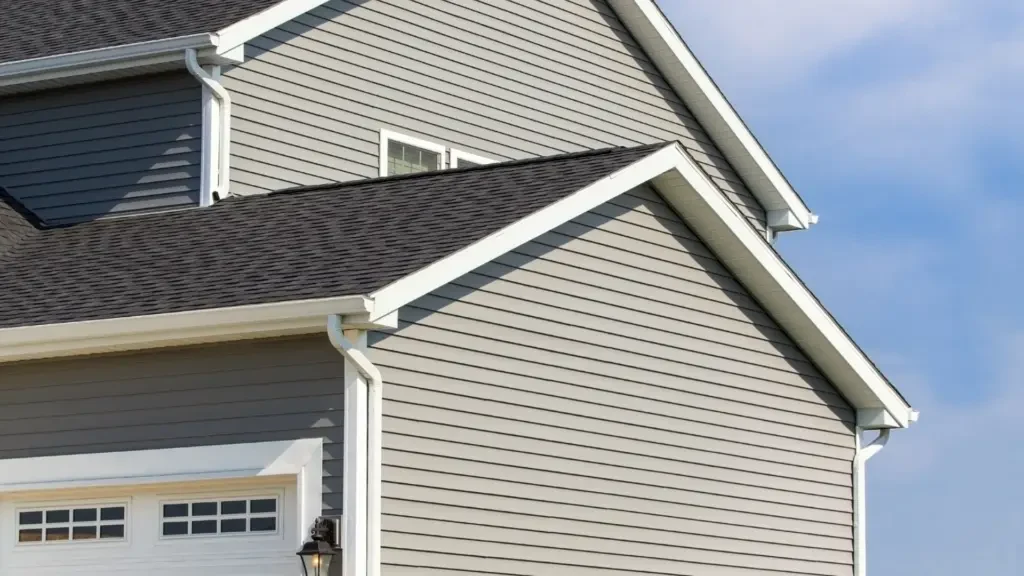
Alternative Solutions
If traditional methods of removing paint from vinyl siding prove ineffective, you can explore some alternative solutions. Here are a few options that may work for your specific paint removal needs:
PEC-12
PEC-12 is a professional-grade cleaner used by photographers to clean film negatives and transparencies. This powerful solvent could potentially dissolve paint, making it easier for you to remove it from your vinyl siding. To use PEC-12, simply follow the packaging instructions and apply it onto the affected area with a clean, soft cloth.
Liquid Wax
Liquid wax offers a gentle alternative that can help you remove paint without damaging your vinyl siding. Use a clean cloth to apply the liquid wax to the painted area in a circular motion. The wax should gradually lift the paint, allowing you to wipe it away with another clean cloth.
Nail Polish Remover
Nail polish remover containing acetone can break down and dissolve paint on vinyl siding. To use this method, moisten a clean cloth with nail polish remover and gently rub it onto the paint stain.
Be cautious, as acetone is a strong solvent and may cause discoloration or damage to the siding if used in excess.
Baking Soda
Baking soda can help remove paint by adding a gentle abrasion to your cleaning solution. Mix a solution of Goof Off or Goo Gone (source search result 1) with baking soda to create a paste.
Apply a thin layer of this paste onto the paint stain, and then use a scrubbing pad to gently scrub the area. The abrasion provided by the baking soda combined with the lifting properties of the cleaning solution should help remove the paint from your siding.
Remember to always test these alternative solutions on a small, inconspicuous area of your siding before applying them to a larger area, in order to ensure they will not cause any unintended damage.
Also, always follow proper safety precautions when using any chemicals, such as wearing gloves and a respirator mask.

